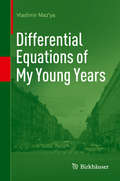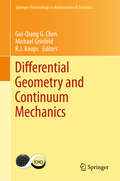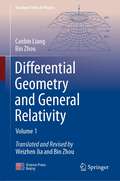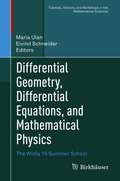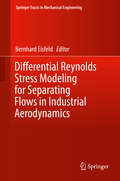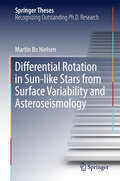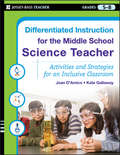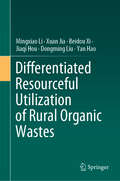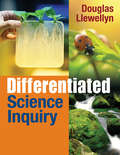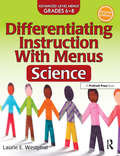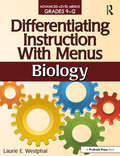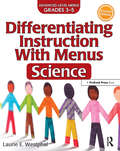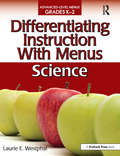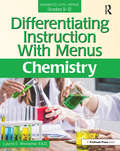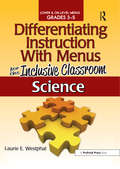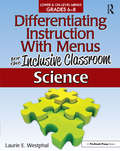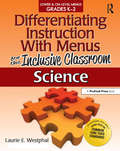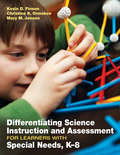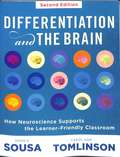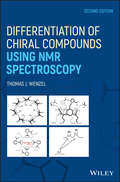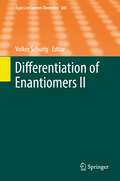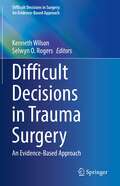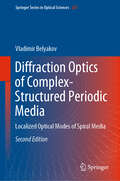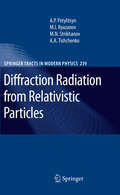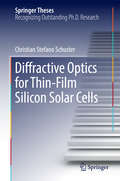- Table View
- List View
Differential Equations of My Young Years
by Vladimir Maz'YaVladimir Maz'ya (born 1937) is an outstanding mathematician who systematically made fundamental contributions to a wide array of areas in mathematical analysis and in the theory of partial differential equations. In this fascinating book he describes the first thirty years of his life. He starts with the story of his family, speaks about his childhood, high school and university years, describe his formative years as a mathematician. Behind the author's personal recollections, with his own joys, sorrows and hopes, one sees a vivid picture of the time. He speaks warmly about his friends, both outside and inside mathematics. The author describes the awakening of his passion for mathematics and his early achievements. He mentions a number of mathematicians who influenced his professional life. The book is written in a readable and inviting way sometimes with a touch of humor. It can be of interest for a very broad readership.
Differential Geometry and Continuum Mechanics
by Gui-Qiang G. Chen Michael Grinfeld R. J. KnopsThis book examines the exciting interface between differential geometry and continuum mechanics, now recognised as being of increasing technological significance. Topics discussed include isometric embeddings in differential geometry and the relation with microstructure in nonlinear elasticity, the use of manifolds in the description of microstructure in continuum mechanics, experimental measurement of microstructure, defects, dislocations, surface energies, and nematic liquid crystals. Compensated compactness in partial differential equations is also treated. The volume is intended for specialists and non-specialists in pure and applied geometry, continuum mechanics, theoretical physics, materials and engineering sciences, and partial differential equations. It will also be of interest to postdoctoral scientists and advanced postgraduate research students. These proceedings include revised written versions of the majority of papers presented by leading experts at the ICMS Edinburgh Workshop on Differential Geometry and Continuum Mechanics held in June 2013. All papers have been peer reviewed.
Differential Geometry and General Relativity: Volume 1 (Graduate Texts in Physics)
by Canbin Liang Bin ZhouThis book, the first in a three-volume set, explains general relativity using the mathematical tool of differential geometry. The book consists of ten chapters, the first five of which introduce differential geometry, which is widely applicable even outside the field of relativity. Chapter 6 analyzes special relativity using geometric language. In turn, the last four chapters introduce readers to the fundamentals of general relativity. Intended for beginners, this volume includes numerous exercises and worked-out example in each chapter to facilitate the learning experience. Chiefly written for graduate-level courses, the book’s content will also benefit upper-level undergraduate students, and can be used as a reference guide for practicing theoretical physicists.
Differential Geometry, Differential Equations, and Mathematical Physics: The Wisła 19 Summer School (Tutorials, Schools, and Workshops in the Mathematical Sciences)
by Maria Ulan Eivind SchneiderThis volume presents lectures given at the Wisła 19 Summer School: Differential Geometry, Differential Equations, and Mathematical Physics, which took place from August 19 - 29th, 2019 in Wisła, Poland, and was organized by the Baltic Institute of Mathematics. The lectures were dedicated to symplectic and Poisson geometry, tractor calculus, and the integration of ordinary differential equations, and are included here as lecture notes comprising the first three chapters. Following this, chapters combine theoretical and applied perspectives to explore topics at the intersection of differential geometry, differential equations, and mathematical physics. Specific topics covered include:Parabolic geometryGeometric methods for solving PDEs in physics, mathematical biology, and mathematical financeDarcy and Euler flows of real gasesDifferential invariants for fluid and gas flowDifferential Geometry, Differential Equations, and Mathematical Physics is ideal for graduate students and researchers working in these areas. A basic understanding of differential geometry is assumed.
Differential Reynolds Stress Modeling for Separating Flows in Industrial Aerodynamics
by Bernhard EisfeldThis book presents recent progress in the application of RANS turbulence models based on the Reynolds stress transport equations. A variety of models has been implemented by different groups into different flow solvers and applied to external as well as to turbo machinery flows. Comparisons between the models allow an assessment of their performance in different flow conditions. The results demonstrate the general applicability of differential Reynolds stress models to separating flows in industrial aerodynamics.
Differential Rotation in Sun-like Stars from Surface Variability and Asteroseismology
by Martin Bo NielsenIn his PhD dissertation Martin Bo Nielsen performs observational studies of rotation in stars like the Sun. The interior rotation in stars is thought to be one of the driving mechanisms of stellar magnetic activity, but until now this mechanism was unconstrained by observational data. NASA's Kepler space mission provides high-precision observations of Sun-like stars which allow rotation to be inferred using two independent methods: asteroseismology measures the rotation of the stellar interior, while the brightness variability caused by features on the stellar surface trace the rotation of its outermost layers. By combining these two techniques Martin Bo Nielsen was able to place upper limits on the variation of rotation with depth in five Sun-like stars. These results suggest that the interior of other Sun-like stars also rotate in much the same way as our own Sun.
Differentiated Instruction for the Middle School Science Teacher
by Joan D'Amico Kate GallawayAn indispensable guide for middle school science teachers who have inclusive classrooms The third volume in the Differentiated Instruction series, Differentiated Instruction for the Middle School Science Teacher offers teachers proven techniques for designing and delivering effective science instruction, measuring success, getting students to work together, and collaborating with other professionals. The ready-to-use activities are tied to core curriculum standards for middle school students and each lesson incorporates adaptations for students with different learning needs. Includes strategies for teaching a standards-based science curriculum Contains a wealth of activities that can be adapted for learners of all abilities Offers information for delivering effective instruction, measuring success, and student collaboration The authors, both experienced teachers, offer a range of techniques, such as station/group activities, enrichment activities, and modifications for students with specific disabilities.
Differentiated Resourceful Utilization of Rural Organic Wastes
by Mingxiao Li Xuan Jia Beidou Xi Jiaqi Hou Dongming Liu Yan HaoThis book systematically introduces the key technologies for differentiated resourceful utilization of rural organic wastes based on high-efficiency anaerobic fermentation and bio-augmented composting, and discusses differentiating sources of organic wastes, integrating recycling technologies, developing key equipment, and researching management mechanisms. In addition, it describes the development of viable techniques and low-pollution, low-cost, and low-maintenance equipment. It also includes the technical specifications for the differentiated resourceful utilization of rural organic wastes and presents the energy-fertilizer integrated resourceful utilization method for rural organic wastes. Providing technological insights into improving the resourceful utilization level of rural organic wastes, this book is a valuable reference resource for administrative staff, researchers in the field of environmental protection, and technicians in enterprises involved in the treatment and disposal of solid wastes.
Differentiated Science Inquiry
by Douglas J. LlewellynIgnite science learning with differentiated instruction One type of science instruction does not fit all. Best-selling author Douglas Llewellyn gives teachers standards-based strategies for differentiating science education to more effectively meet the needs of all students. This book takes the concept of inquiry-based science instruction to a deeper level, includes a compelling case study, and demonstrates: Methods for determining when and how to provide students with more choices, thereby increasing their ownership and motivation Ways to implement differentiated science inquiry in the main areas of science instruction Strategies for successfully managing the classroom
Differentiating Instruction With Menus: Science (Grades 6-8)
by Laurie E. WestphalThe best-selling Differentiating Instruction With Menus series has helped teachers nationwide differentiate instruction for their high-ability learners with easy-to-use menus and exciting tools to challenge and reach gifted and advanced students in the classroom. Each book includes an updated, student-friendly rubric that can assess different types of products, free choice proposal forms to encourage independent study, and new and favorite challenging menus to meet the needs of these diverse higher level learners. Readers will also be able to save time by using updated guidelines that reflect changes in technology for each of the products included in the menus and find direct alignment with standards approved in recent years. Topics addressed in Differentiating Instruction With Menus: Science (Grades 6-8, 2nd ed.) include process skills, physical sciences, life sciences, and Earth and space sciences.Grades 6-8
Differentiating Instruction With Menus: Biology (Grades 9-12)
by Laurie E. WestphalDifferentiating Instruction With Menus: Biology offers teachers everything needed to create a student-centered learning environment based on choice. This book presents six different types of menus that students can use to select exciting advanced-level products that they will develop so teachers can assess what has been learned, instead of using a traditional worksheet format. Topics addressed include biology basics, biodiversity and environments, genetics, human body systems, and the different phyla typically included in the biology curriculum. Differentiating Instruction With Menus: Biology contains attractive reproducible menus, each based on the levels of Bloom's revised taxonomy as well as incorporating different learning styles. These menus can be used to guide students in making decisions as to which products they will develop after studying a major concept or unit.Grades 9-12
Differentiating Instruction With Menus: Science (Grades 3-5)
by Laurie E. WestphalThe best-selling Differentiating Instruction With Menus series has helped teachers nationwide differentiate instruction for their high-ability learners with easy-to-use menus and exciting tools to challenge and reach gifted and advanced students in the classroom. Each book includes an updated, student-friendly rubric that can assess different types of products, free choice proposal forms to encourage independent study, and new and favorite challenging menus to meet the needs of these diverse higher level learners. Readers will also be able to save time by using updated guidelines that reflect changes in technology for each of the products included in the menus and find direct alignment with standards approved in recent years. Topics addressed in Differentiating Instruction With Menus: Science (Grades 3-5, 2nd ed.) include physical science, biological science, Earth science, and scientists and the tools they use.Grades 3-5
Differentiating Instruction With Menus: Science (Grades K-2)
by Laurie E. WestphalThe Differentiating Instruction With Menus series offers teachers exciting tools to challenge and reach both gifted and advanced students in the classroom. Whether these students need enrichment, choice in independent practice, or even additional academic options resulting from curriculum compacting, these books provide teachers a complete ready-to-use resource. Each book includes a rubric that can assess different types of products, free choice proposal forms to encourage independent study, specific guidelines for each of the products included in the menus to save the teacher time, and challenging menus to meet the needs of these diverse higher level learners.Differentiating Instruction With Menus: Science (Grades K-2) contains attractive reproducible menus, based on the levels of Bloom's revised taxonomy, that students can use as a guide when making decisions about which products they will develop after they study a major concept or unit. Topics addressed include life science, Earth science, and physical science.The products included on the menu are carefully selected from various learning styles to build students' excitement and so that teachers can more accurately assess the depth of what has been learned. Using creative and challenging choices found in Three-Shape Menus, Tic-Tac-Toe Menus, Meal Menus, Give Me Five Menus, 2-5-8 Menus, and List Menus, students will look forward to sharing their newfound knowledge throughout the year!Grades K-2
Differentiating Instruction With Menus: Chemistry (Grades 9-12)
by Laurie E. WestphalDifferentiating Instruction With Menus: Chemistry offers teachers everything needed to create a student-centered learning environment based on choice. This book uses different types of menus that students can use to select exciting advanced-level products that they will develop so teachers can assess what has been learned—instead of using a traditional worksheet format. Topics addressed include chemistry basics, measurements, atoms, chemical bonding and reactions, gas laws, energy, acids and bases, and nuclear and organic chemistry. Differentiating Instruction With Menus: Chemistry contains attractive reproducible menus, each based on the levels of Bloom's revised taxonomy as well as incorporating different learning styles. These menus can be used to guide students in making decisions as to which products they will develop after studying a major concept or unit.Grades 9-12
Differentiating Instruction With Menus for the Inclusive Classroom: Science (Grades 3-5)
by Laurie E. WestphalDifferentiating Instruction With Menus for the Inclusive Classroom: Science for grades 3-5 offers teachers everything they need to create a student-centered learning environment based on choice. This book provides six different types of menus that students can use to select exciting products that they will develop so teachers can assess what has been learned—instead of using a traditional worksheet format. Topics addressed include physical science, biological science, Earth science, and tools scientists use.Differentiating Instruction With Menus for the Inclusive Classroom: Science provides numerous types of leveled menus that lower and on-level elementary-aged students can use to demonstrate learning through a method of their choice. Menus with similar formats but geared towards varying ability levels allow teachers to differentiate easily. Using the creative and challenging choices found in Tic-Tac-Toe menus, List menus, 2-5-8 menus, Three Shape menus, Baseball menus, and Game Show menus, students will look forward to sharing their newfound knowledge throughout the year. Also included are specific guidelines for products, rubrics for assessing student products, and teacher introduction pages for each menu. This is a must-have for any teacher wanting to differentiate for a wide range of learners!Grades 3-5
Differentiating Instruction With Menus for the Inclusive Classroom: Science (Grades 6-8)
by Laurie E. WestphalDifferentiating Instruction With Menus for the Inclusive Classroom: Science for grades 6-8 offers teachers who have multiple ability levels in one classroom everything they need to create a student-centered learning environment based on choice. For each topic covered, there are two menus that look similar but contain differentiated content: one menu for students working on grade level and the other for students working below grade level. Using the creative, challenging choices found in Tic-Tac-Toe menus, List menus, 2-5-8 menus, and Game Show menus, students will demonstrate their knowledge with unique, exciting products. Also included are specific guidelines for products, assessment rubrics, and teacher introduction pages for each menu. These menus can also be used in conjunction with the Differentiating Instruction With Menus series (for students working above grade level) for three tiers of complementary menus.Grades 6-8
Differentiating Instruction With Menus for the Inclusive Classroom: Science (Grades K-2)
by Laurie E. WestphalDifferentiating Instruction With Menus for the Inclusive Classroom: Science for grades K-2 offers teachers everything needed to create a student-centered learning environment based on choice. This book provides seven different types of menus that students can use to select exciting products that they will develop so teachers can assess what has been learned instead of using a traditional worksheet format. Topics addressed include life sciences, Earth sciences, and physical sciences. Differentiating Instruction With Menus for the Inclusive Classroom: Science provides numerous types of leveled menus that lower and on-level primary-age students can use to select exciting products to demonstrate learning. Menus with similar formats but geared toward varying ability levels allow teachers to differentiate easily. Using the creative and challenging choices found in Meal menus, Tic-Tac-Toe menus, Target-Based List menus, 2-5-8 menus, Give Me 5 menus, Three-Shape menus, and Pick 3 menus, students will look forward to sharing their newfound knowledge throughout the year. Also included are specific guidelines for products, rubrics for assessing student products, and teacher introduction pages for each menu. This is a must-have for any teacher wanting to differentiate for a wide range of learners!Grades K-2
Differentiating Science Instruction and Assessment for Learners With Special Needs, K–8
by Kevin D. Finson Christine K. Ormsbee Mary M. JensenField-tested strategies for teaching science to students with special needs This timely, practical guidebook shows general and special educators how to retool science activities and assessments for students with special needs. The authors cover a broad range of topics in an orderly, concise fashion, including: National and state requirements for science learning Pedagogical strategies for collaborative learning groups, individual contracts, self-paced learning centers, literature circles, and team projects Grade-appropriate ways to revise science activities and assessments Step-by-step instructions for using rubrics for evaluation, revision, and assessment Information on teacher collaboration and specific disabilities
Differentiation And The Brain: How Neuroscience Supports The Learner-friendly Classroom
by David A. Sousa Carol Ann TomlinsonStudents are becoming more academically and culturally diverse, making it more important than ever to shift away from a one-size-fits-all approach and toward differentiated instruction. The second edition of this best-selling book will help you create truly effective, brain-friendly classrooms for all learners. The authors share an array of updated differentiated instruction examples, scenarios, and exercises, as well as the latest educational psychology research from cognitive psychology, neuroscience, and pedagogy. Learn more about teaching diverse learners using brain-based learning strategies: Explore how the brain learns and approaches to differentiated instruction. Sharpen your knowledge of developmental cognitive neuroscience and educational psychology to teach the best content in the best possible way. Use the knowledge of educational neuroscience (neuroeducation) to benefit the students you teach. Design and implement strategies for effective differentiated instruction. Create a positive and productive learning environment that supports diversity in the classroom. A joint publication of ASCD and Solution Tree
Differentiation of Chiral Compounds Using NMR Spectroscopy
by Thomas J. WenzelAn updated guide to the most current information available for determining how to use NMR spectroscopy to differentiate chiral compounds Differentiation of Chiral Compounds Using NMR Spectroscopy offers a thoroughly revised second edition to the essential volume that puts the focus on the chiral systems that are commercially available and have been widely vetted for use in NMR spectroscopy. The text covers a broad range of reagents that make it possible to determine the enantiomeric purity and assign the absolute configuration of many classes of compounds. Comprehensive in scope, the text describes the chiral NMR differentiating agents as derivatizing agents, solvating agents, metal-based reagents and liquid crystals and gels, and explains the range and types of compounds for which they can be used for analysis. New to this edition are the most recent findings in the field as well as the development of advanced NMR measurement techniques that allow for the simplification of complex spectra resulting in more readily identified enantiodifferentiation. This important resource: Includes the most recent coverage of a large range of compounds that can be analyzed using chiral NMR reagents Explores the use of chiral NMR reagents and explains their relationship to the stereochemistry of the analyzed molecules Offers the essential information needed to help decide which method is the best NMR method to apply to a class or molecules Contains experimental strategies for using the reagents that are likely to improve the quality of the results Differentiation of Chiral Compounds Using NMR Spectroscopy is a comprehensive guide designed for investigators planning to use NMR spectroscopy to determine enantiomeric purity or assign the absolute configuration of a compound.
Differentiation of Enantiomers I
by Volker SchurigThe series Topics in Current Chemistry presents critical reviews of the present and future trends in modern chemical research. The scope of coverage is all areas of chemical science including the interfaces with related disciplines such as biology, medicine and materials science. The goal of each thematic volume is to give the non-specialist reader, whether in academia or industry, a comprehensive insight into an area where new research is emerging which is of interest to a larger scientific audience. Each review within the volume critically surveys one aspect of that topic and places it within the context of the volume as a whole. The most significant developments of the last 5 to 10 years are presented using selected examples to illustrate the principles discussed. The coverage is not intended to be an exhaustive summary of the field or include large quantities of data, but should rather be conceptual, concentrating on the methodological thinking that will allow the non-specialist reader to understand the information presented. Contributions also offer an outlook on potential future developments in the field.
Difficult Decisions in Trauma Surgery: An Evidence-Based Approach (Difficult Decisions in Surgery: An Evidence-Based Approach)
by Kenneth Wilson Selwyn O. RogersThis book provides a practical guide to decision making within the realm of trauma surgery. Each chapter covers the ideal approach, rather than customary care, for the treatment of the chosen difficult decision or controversy. A broad range of topics are covered with particular attention given to resuscitation, wound management, thoracic and abdominal trauma, antimicrobial management, transplant considerations, vascular trauma, traumatic brain injury, pediatric trauma and ethics.Difficult Decisions in Trauma Surgery aims to help improve the treatment of trauma patients and is relevant to surgical trainees and practicing surgeons, and as well as medical professionals working within trauma medicine.
Diffraction Optics of Complex-Structured Periodic Media: Localized Optical Modes of Spiral Media (Springer Series in Optical Sciences #203)
by Vladimir BelyakovThis book presents recent theoretical and experimental results of localized optical modes and low-threshold lasing in spiral photonic media. Efficient applications of localized modes for low-threshold lasing at the frequencies of localized modes are a central topic of the book's new chapters. Attention is paid to the analytical approach to the problem. The book focuses on one of the most extensively studied media in this field, cholesteric liquid crystals. The chosen model, in the absence of dielectric interfaces, allows to remove the problem of polarization mixing at surfaces, layers and defect structures. It allows to reduce the corresponding equations to the equations for light of diffracting polarization only. The problem concentrates then on the edge and defect optical modes. The possibility to reduce the lasing threshold due to an anomalously strong absorption effect is presented theoretically for distributed feedback lasing. It is shown that a minimum of the threshold-pumping wave intensity can be reached for the pumping wave frequency coinciding with the localized mode frequency (what can be reached for a pumping wave propagating at a certain angle to the helical axes). Analytic expressions for transmission and reflection coefficients are presented. In the present second edition, experimental observations of theoretically revealed phenomena in spiral photonic media are discussed. The main results obtained for spiral media are qualitatively valid for photonic crystals of any nature and therefore may be applied as a guide to investigations of other photonic crystals where the corresponding theory is more complicated and demands a numerical approach. It is demonstrated that many optical phenomena occurring at the frequencies of localized modes reveal unusual properties which can be used for efficient applications of the corresponding phenomena, efficient frequency conversion and low threshold lasing, e.g. For the convenience of the reader, an introduction is given to conventional linear and nonlinear optics of structured periodic media. This book is valuable to researchers, postgraduate, and graduate students active in theoretical and experimental physics in the field of interaction of radiation with condensed matter.
Diffraction Radiation from Relativistic Particles
by Alexey Alexandrovich Tishchenko Alexander Potylitsyn Mikhail Nikolaevich Strikhanov Mikhail Ivanovich RyazanovThis book deals with diffraction radiation, which implies the boundary problems of electromagnetic radiation theory. Diffraction radiation is generated when a charged particle moves near a target edge at a distance ( - Lorentz factor, - wave length). Diffraction radiation of non-relativistic particles is widely used to design intense emitters in the cm wavelength range. Diffraction radiation from relativistic charged particles is important for noninvasive beam diagnostics and design of free electron lasers based on Smith-Purcell radiation which is diffraction radiation from periodic structures. Different analytical models of diffraction radiation and results of recent experimental studies are presented in this book. The book may also serve as guide to classical electrodynamics applications in beam physics and electrodynamics. It can be of great use for young researchers to develop skills and for experienced scientists to obtain new results.
Diffractive Optics for Thin-Film Silicon Solar Cells
by Christian Stefano SchusterThis thesis introduces a figure of merit for light trapping with photonic nanostructures and shows how different light trapping methods compare, irrespective of material, absorber thickness or type of nanostructure. It provides an overview of the essential aspects of light trapping, offering a solid basis for future designs. Light trapping with photonic nanostructures is a powerful method of increasing the absorption in thin film solar cells. Many light trapping methods have been studied, but to date there has been no comprehensive figure of merit to compare these different methods quantitatively. This comparison allows us to establish important design rules for highly performing structures; one such rule is the structuring of the absorber layer from both sides, for which the authors introduce a novel and simple layer-transfer technique. A closely related issue is the question of plasmonic vs. dielectric nanostructures; the authors present an experimental demonstration, aided by a detailed theoretical assessment, highlighting the importance of considering the multipass nature of light trapping in a thin film, which is an essential effect that has been neglected in previous work and which allows us to quantify the parasitic losses.
